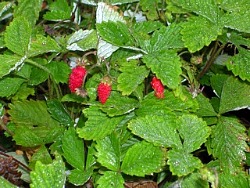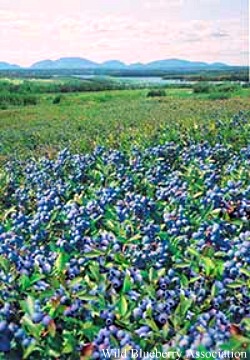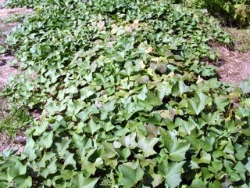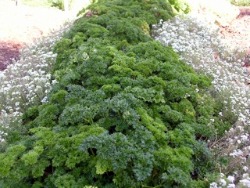

Alpine strawberries feature tasty small berries on diminutive plants that flower and fruit all summer long.

Cranberries don't need bogs to grow. Plant yours where ever blueberries thrive and enjoy making your own cranberry sauce around the holidays.
In this newsletter I often talk about edible plants replacing ornamental trees, shrubs and flowers in your landscape. However, a less obvious area where you can also incorporate edibles is in your ground covers. Low growing edibles can fill in spaces under trees and shrubs, grow in walkways, or be used in the front of flower beds. While ground covers with edible leaves are the first types that come to mind, there are many low growing edibles with delicious fruits as well. Edible ground covers are also great for small space gardens where maximizing the available growing area is essential. You can even grow most of these edible ground covers in containers to enjoy them on decks and patios.
So, take a look at your landscape and give some thought to growing some edible ground covers. It's a way to grow more food in less space.
Choosing your Ground CoversAs with any plant, when deciding which edible to grow consider the sun exposure, soil conditions, and usage of that area. Select the right ground cover for the use. If you're trying to grow edible ground covers under a tree or shrub, look for shade lovers. If you're growing edible ground covers near acid loving shrubs, such as rhododendrons, consider plants with similar soil requirements. If you're growing ground covers in heavily traveled areas of your yard, look for ones that can withstand some foot traffic and still thrive.
Here are some of the best edible ground covers to grow in your yard.
Alpine strawberries (Fragaria x vesca) – These low growing, small fruited plants are perfect for the front of a garden bed, container, or tucked in among low growing flowers. They grow into a 6-inch tall mound and, unlike other strawberries, don't send out runners, so plants stay relatively contained. Alpine strawberries are also day neutral so they produce all summer long until frost. They need full sun and well-drained fertile soil to grow their best, but tolerate a little shade better than larger-fruited strawberry varieties. The fruits are 1/2-inch long and wide, but pack a strong strawberry flavor. They're great for munching in the garden or adding a handful to cereal or desserts. Spaced about 1 foot apart in the garden, the plants will eventually form a solid mass and may need dividing after 3 to 4 years. Some good red fruited varieties to try are 'Alexandria' and 'Mignonette'. The unique 'Yellow Wonder' variety has light colored fruits that birds don't bother.
Lingonberries & Cranberries (Vaccinium spp) – These heath-family ground covers have beautiful evergreen leaves and bright red, tart berries in summer and fall. The leaves actually turn red in fall too, making a stand of lingonberries and cranberries very attractive additions to a flower border. Lingonberries are native to Scandinavia where they're very popular for use in tangy jams, jellies, syrups and sauces. Lingonberry pancake syrup is a personal favorite! They are loaded with vitamin C and antioxidants.
Cranberries are North American natives that produce tangy red berries used in jams, jellies and juices. Although commercial cranberry bogs are flooded with water for ease of harvesting each year, home-grown cranberries don't need all that water. Cranberries and lingonberries grow fine wherever blueberries can grow.
The key to growing lingonberries and cranberries successfully is full sun (part sun in hot climates), and moist, acidic soil. Amending the soil with peat moss, sulfur and compost will get them off to a good start. These evergreens are hardy to zones 3 and 4, but may have some die back during cold, snowless winters. Keep plants well weeded, watered and fertilized in spring to help the leaves green up. The plants will eventually spread and create an evergreen mat with beautiful berries. Harvested berries can be frozen and used as needed in winter.

Low bush blueberries have more flavor and antioxidants than larger fruited varieties, but require more work to grow and harvest.

Sweet potatoes make an attractive ground cover and by fall produce an abundance of edible tubers.

Parsley is an attractive edible ground cover that compliments other annuals flowers and attracts swallowtail butterflies to the garden.
Creeping Oregon grape (Mahonia aquifolium) – Okay, so this may not be my favorite edible, but the sour fruits of Oregon grape can be used in making jams, pies, wines and jellies. This 1-foot tall, creeping evergreen plant is hardy to zone 5 and can tolerate some shade, so makes a nice addition between trees, shrubs and other plants in your landscape. Yellow flowers are produced in spring and the blue berries are best harvested after a frost, which improves their flavor.
Wintergreen (Gaultheria procumbens) – Wintergreen is also known as boxberry or eastern teaberry. This native evergreen has leaves with wintergreen flavor when your chew them, just like the gum! Hardy in zones 3 to 8, it is a 4- to 6-inch tall, shade loving plant that produces white flowers in spring and red berries in summer and fall. The berries hang on the plant into winter unless you or some animal decides to eat them. The red berries also have that wintergreen flavor, making them a mouth popping addition to a fruit salad. Plant in shade under deciduous trees on well drained, slightly acidic soil. Keep the plants moist, especially when young. They're slow growing, but make a tasty addition to your understory.
Lowbush blueberries (Vaccinium angustifolium) – These are the classic wild blueberries found on rocky crags and in openings in the woods. The plants only grow 8- to 12-inches tall and are hardy to zone 3, making theses tough plants good additions to partly sunny areas along a woods or in the garden. Like all blueberries, the key is planting in well drained, moist acidic soil.
Low bush blueberries are unlike other blueberries because they have a 2-year fruiting cycle. Plants that fruit one year need to put on more vegetative growth the second year before fruiting again. For this reason they're often mowed down in fall in commercial operations to stimulate new growth. If not mowed back, the fruit production declines. Although harder to pick than high bush varieties, these blueberries have a more intense flavor and make great pies, jams and sauces. The plants spread by underground runners to fill in an area over time.
Herbs – If you're looking for an edible ground cover to grow in a high traffic area, think herbs. Mint and thyme in particular can withstand some foot traffic to produce flavorful leaves. Creeping thyme grows well between steps, along a walkway or in the garden. There's nothing like the scent of thyme as you walk along your garden path. If you like a mint scent, try Corsican mint. This 1/2 inch tall creeper gives off a crème-de-menthe scent when walked upon. Remember mint and thyme can stand some foot traffic but certainly not as much as lawn grass. Use low growing, larger leaved mints, such as English mint (Mentha spicata), if you're growing the mint to harvest for eating as well. For a beautiful green border, try growing curly or flat leaved parsley. They contrast well with colorful flowers and withstand cold weather staying green all season. For a woodier, low growing plant, try prostrate rosemary. Rosemary looks great cascading down a wall or over the edge of a container. Rosemary is only hardy to zone 7.
Sweet Potato – There was a time when sweet potatoes were grown just for their edible tubers. However, with the advent of different colored foliage vines, such as lime colored 'Marguerite' and burgundy colored 'Blackie', you can have a beautiful ground cover sweet potato that you eat at the end of the growing season. While the ornamental sweet potato vines mentioned above do produce edible tubers, if you really want to get some tasty sweet potatoes, stick with varieties such as ''Bush Porto Rico' and 'Centennial'.
 Charlie Nardozzi is an award winning, nationally recognized garden writer, speaker, radio, and television personality. He has worked for more than 30 years bringing expert gardening information to home gardeners through radio, television, talks, tours, on-line, and the printed page. Charlie delights in making gardening information simple, easy, fun and accessible to everyone. He's the author of 6 books, has three radio shows in New England and a TV show. He leads Garden Tours around the world and consults with organizations and companies about gardening programs. See more about him at Gardening With Charlie.
Charlie Nardozzi is an award winning, nationally recognized garden writer, speaker, radio, and television personality. He has worked for more than 30 years bringing expert gardening information to home gardeners through radio, television, talks, tours, on-line, and the printed page. Charlie delights in making gardening information simple, easy, fun and accessible to everyone. He's the author of 6 books, has three radio shows in New England and a TV show. He leads Garden Tours around the world and consults with organizations and companies about gardening programs. See more about him at Gardening With Charlie.
 Victory Seed Company has all the seeds you want for your best garden in 2024.
Victory Seed Company has all the seeds you want for your best garden in 2024.
For 25 years, the family-owned Victory Seed Company has provided the highest quality vegetable, herb and flower seeds to families across the country. We are passionate about providing you the best seeds available that give excellent germination, robust plants, and the harvest you want. With a catalog of over a thousand varieties, we have everything, and our prices are the kinds that we'd want to pay. We have hundreds of yesterday's heirloom vegetables, as well as today's award winning hybrid selections. Get to know us by visiting our website and browsing through our online vegetable seed catalog.